Environmental Impact and Protection in Maritime Industry - Report
VerifiedAdded on 2022/11/18
|8
|2576
|487
Report
AI Summary
This report provides a comprehensive overview of the environmental impact and protection measures within the maritime industry. It examines the various sources of pollution, including garbage, oil, and sulfur gas emissions, and their detrimental effects on the marine environment. The paper delves into the role of international conventions, primarily focusing on the International Maritime Organization (IMO) and the International Convention for the Prevention of Pollution from Ships (MARPOL). It details specific conventions such as the Ballast Water Management Plan, Shipboard Oil Pollution Emergency Plan, International Oil Pollution Prevention, International Air Pollution Prevention, International Energy Efficiency Certification, and Garbage Management Plan, explaining their objectives, regulations, and impact on mitigating pollution. The report highlights how these conventions address different types of pollution by setting emission limits, defining waste disposal methods, and mandating safety measures like double hulls and energy efficiency standards. It also emphasizes the continuous amendments and adaptations of these conventions to address emerging environmental challenges and promote sustainable practices within the maritime sector. The report concludes by summarizing the significance of these international efforts in safeguarding the maritime environment.
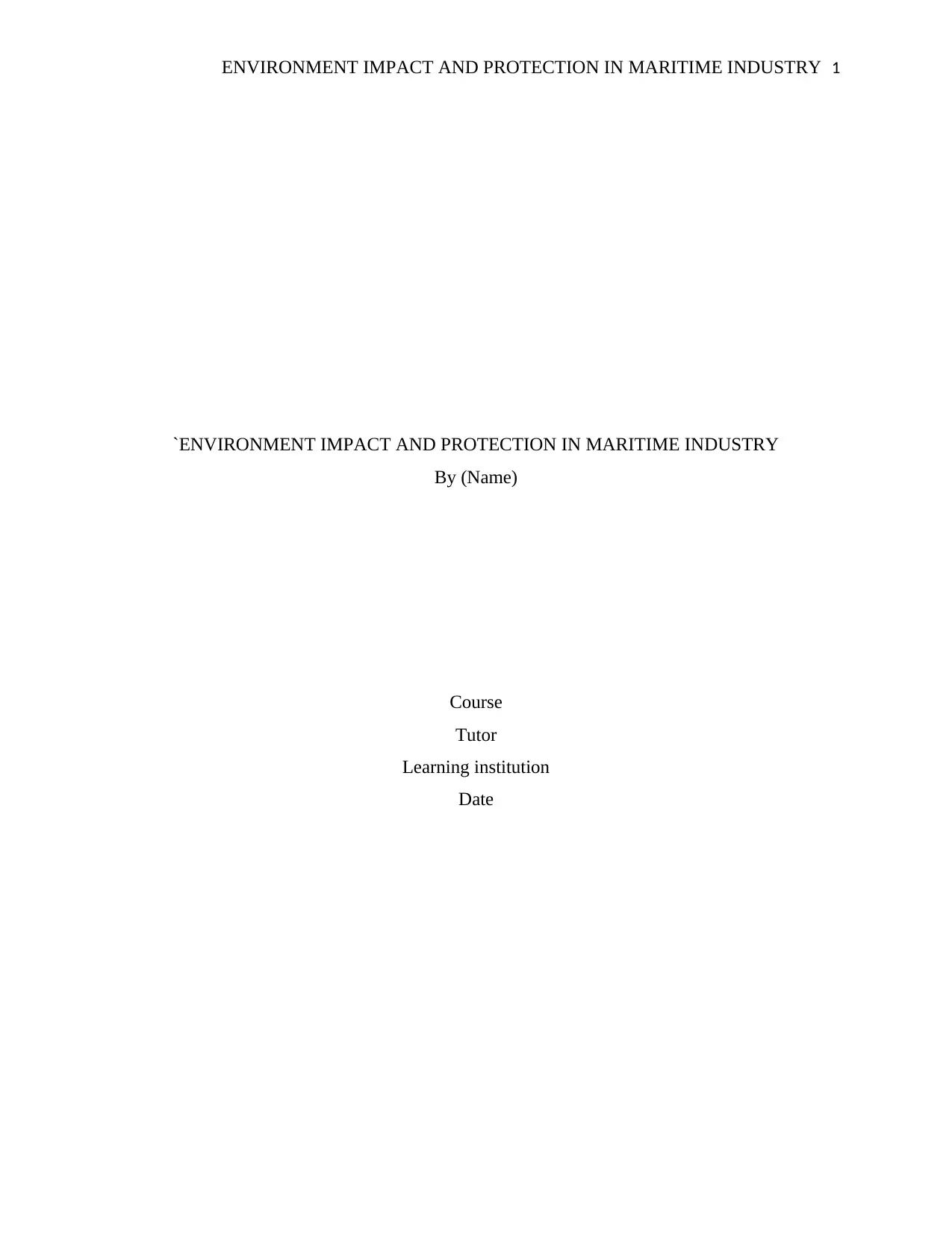
ENVIRONMENT IMPACT AND PROTECTION IN MARITIME INDUSTRY 1
`ENVIRONMENT IMPACT AND PROTECTION IN MARITIME INDUSTRY
By (Name)
Course
Tutor
Learning institution
Date
`ENVIRONMENT IMPACT AND PROTECTION IN MARITIME INDUSTRY
By (Name)
Course
Tutor
Learning institution
Date
Paraphrase This Document
Need a fresh take? Get an instant paraphrase of this document with our AI Paraphraser

ENVIRONMENT IMPACT AND PROTECTION IN MARITIME INDUSTRY 2
Abstract
Maritime possess a great ecological threat. Various vessels in the maritime industry directly
impact on the environment. This paper investigates environmental impact and protection in the
maritime industry. There are various international Maritime Organization (IMO) and the
International Convention for the Prevention of Pollution from Ships (MAPROL) aimed at
preventing and limiting pollution in the maritime industry. The commonest among them being;
Ballast water management plan, shipboard oil pollution emergency plan, internal oil pollution
prevention, international air pollution prevention, international energy efficiency cert, and
garbage management plan among so many other conventions addressing various pollutions
caused by ships. The research paper discusses each convention into details and how they
managed to address various sources of maritime pollution. The convention on prevention of air
pollution, for example addressed the issue of air pollution by setting up emission limits for any
toxic gas produced by the ships. This convention defines the limit for emission of rates of gases
for instance, sulfur emissions should not exceed 0.5%. Garbage management plan addressed
pollution caused by garbage by defining each type of garbage and their respective means of
disposal. It defines the distance a garbage release from ships should cover from the disposal
point. It also defines the various types of garbage by outlining those that completely banned from
being released in the sea water. International oil convention asserts that all ships should be fitted
by double hulls aimed at limiting accidental spillage of oil into the sea water. It also defines oil
residues that can be released into sea water. The energy efficiency convention regulated the
energy performance index of all ships while considering the IMO guidelines. Ship oil pollution
emergency plan dictates the various actions in cases of accidental spillage.
Abstract
Maritime possess a great ecological threat. Various vessels in the maritime industry directly
impact on the environment. This paper investigates environmental impact and protection in the
maritime industry. There are various international Maritime Organization (IMO) and the
International Convention for the Prevention of Pollution from Ships (MAPROL) aimed at
preventing and limiting pollution in the maritime industry. The commonest among them being;
Ballast water management plan, shipboard oil pollution emergency plan, internal oil pollution
prevention, international air pollution prevention, international energy efficiency cert, and
garbage management plan among so many other conventions addressing various pollutions
caused by ships. The research paper discusses each convention into details and how they
managed to address various sources of maritime pollution. The convention on prevention of air
pollution, for example addressed the issue of air pollution by setting up emission limits for any
toxic gas produced by the ships. This convention defines the limit for emission of rates of gases
for instance, sulfur emissions should not exceed 0.5%. Garbage management plan addressed
pollution caused by garbage by defining each type of garbage and their respective means of
disposal. It defines the distance a garbage release from ships should cover from the disposal
point. It also defines the various types of garbage by outlining those that completely banned from
being released in the sea water. International oil convention asserts that all ships should be fitted
by double hulls aimed at limiting accidental spillage of oil into the sea water. It also defines oil
residues that can be released into sea water. The energy efficiency convention regulated the
energy performance index of all ships while considering the IMO guidelines. Ship oil pollution
emergency plan dictates the various actions in cases of accidental spillage.
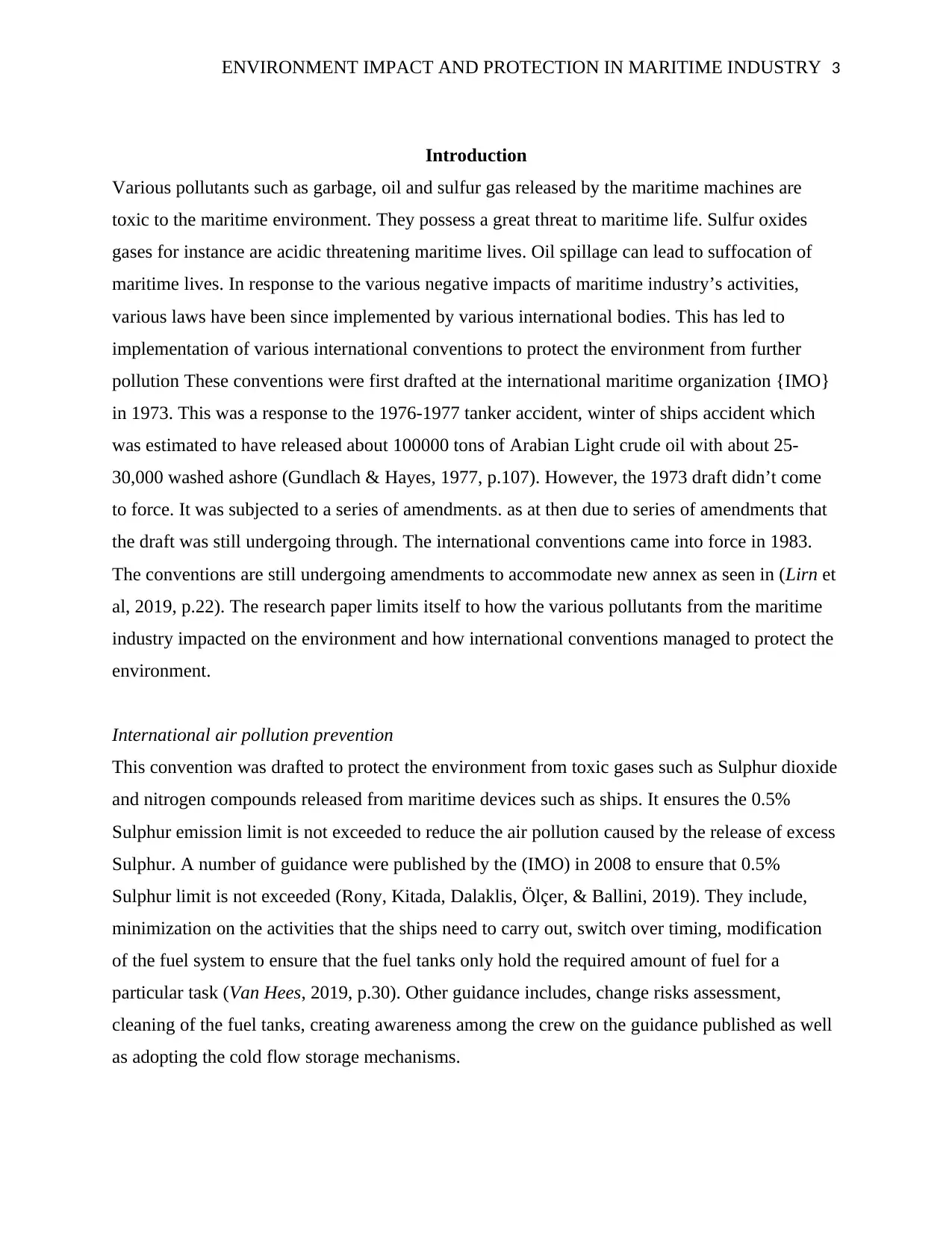
ENVIRONMENT IMPACT AND PROTECTION IN MARITIME INDUSTRY 3
Introduction
Various pollutants such as garbage, oil and sulfur gas released by the maritime machines are
toxic to the maritime environment. They possess a great threat to maritime life. Sulfur oxides
gases for instance are acidic threatening maritime lives. Oil spillage can lead to suffocation of
maritime lives. In response to the various negative impacts of maritime industry’s activities,
various laws have been since implemented by various international bodies. This has led to
implementation of various international conventions to protect the environment from further
pollution These conventions were first drafted at the international maritime organization {IMO}
in 1973. This was a response to the 1976-1977 tanker accident, winter of ships accident which
was estimated to have released about 100000 tons of Arabian Light crude oil with about 25-
30,000 washed ashore (Gundlach & Hayes, 1977, p.107). However, the 1973 draft didn’t come
to force. It was subjected to a series of amendments. as at then due to series of amendments that
the draft was still undergoing through. The international conventions came into force in 1983.
The conventions are still undergoing amendments to accommodate new annex as seen in (Lirn et
al, 2019, p.22). The research paper limits itself to how the various pollutants from the maritime
industry impacted on the environment and how international conventions managed to protect the
environment.
International air pollution prevention
This convention was drafted to protect the environment from toxic gases such as Sulphur dioxide
and nitrogen compounds released from maritime devices such as ships. It ensures the 0.5%
Sulphur emission limit is not exceeded to reduce the air pollution caused by the release of excess
Sulphur. A number of guidance were published by the (IMO) in 2008 to ensure that 0.5%
Sulphur limit is not exceeded (Rony, Kitada, Dalaklis, Ölçer, & Ballini, 2019). They include,
minimization on the activities that the ships need to carry out, switch over timing, modification
of the fuel system to ensure that the fuel tanks only hold the required amount of fuel for a
particular task (Van Hees, 2019, p.30). Other guidance includes, change risks assessment,
cleaning of the fuel tanks, creating awareness among the crew on the guidance published as well
as adopting the cold flow storage mechanisms.
Introduction
Various pollutants such as garbage, oil and sulfur gas released by the maritime machines are
toxic to the maritime environment. They possess a great threat to maritime life. Sulfur oxides
gases for instance are acidic threatening maritime lives. Oil spillage can lead to suffocation of
maritime lives. In response to the various negative impacts of maritime industry’s activities,
various laws have been since implemented by various international bodies. This has led to
implementation of various international conventions to protect the environment from further
pollution These conventions were first drafted at the international maritime organization {IMO}
in 1973. This was a response to the 1976-1977 tanker accident, winter of ships accident which
was estimated to have released about 100000 tons of Arabian Light crude oil with about 25-
30,000 washed ashore (Gundlach & Hayes, 1977, p.107). However, the 1973 draft didn’t come
to force. It was subjected to a series of amendments. as at then due to series of amendments that
the draft was still undergoing through. The international conventions came into force in 1983.
The conventions are still undergoing amendments to accommodate new annex as seen in (Lirn et
al, 2019, p.22). The research paper limits itself to how the various pollutants from the maritime
industry impacted on the environment and how international conventions managed to protect the
environment.
International air pollution prevention
This convention was drafted to protect the environment from toxic gases such as Sulphur dioxide
and nitrogen compounds released from maritime devices such as ships. It ensures the 0.5%
Sulphur emission limit is not exceeded to reduce the air pollution caused by the release of excess
Sulphur. A number of guidance were published by the (IMO) in 2008 to ensure that 0.5%
Sulphur limit is not exceeded (Rony, Kitada, Dalaklis, Ölçer, & Ballini, 2019). They include,
minimization on the activities that the ships need to carry out, switch over timing, modification
of the fuel system to ensure that the fuel tanks only hold the required amount of fuel for a
particular task (Van Hees, 2019, p.30). Other guidance includes, change risks assessment,
cleaning of the fuel tanks, creating awareness among the crew on the guidance published as well
as adopting the cold flow storage mechanisms.
⊘ This is a preview!⊘
Do you want full access?
Subscribe today to unlock all pages.

Trusted by 1+ million students worldwide
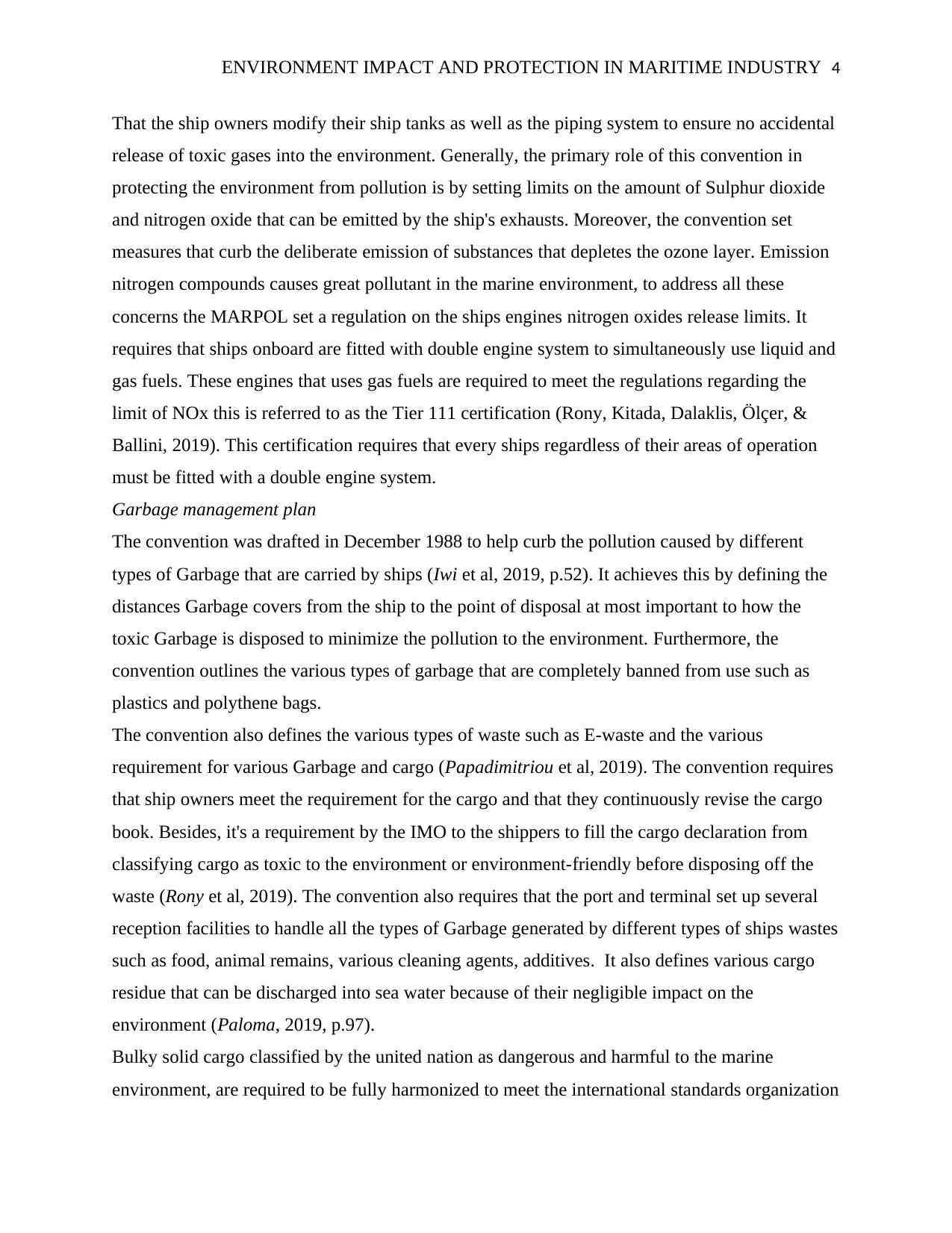
ENVIRONMENT IMPACT AND PROTECTION IN MARITIME INDUSTRY 4
That the ship owners modify their ship tanks as well as the piping system to ensure no accidental
release of toxic gases into the environment. Generally, the primary role of this convention in
protecting the environment from pollution is by setting limits on the amount of Sulphur dioxide
and nitrogen oxide that can be emitted by the ship's exhausts. Moreover, the convention set
measures that curb the deliberate emission of substances that depletes the ozone layer. Emission
nitrogen compounds causes great pollutant in the marine environment, to address all these
concerns the MARPOL set a regulation on the ships engines nitrogen oxides release limits. It
requires that ships onboard are fitted with double engine system to simultaneously use liquid and
gas fuels. These engines that uses gas fuels are required to meet the regulations regarding the
limit of NOx this is referred to as the Tier 111 certification (Rony, Kitada, Dalaklis, Ölçer, &
Ballini, 2019). This certification requires that every ships regardless of their areas of operation
must be fitted with a double engine system.
Garbage management plan
The convention was drafted in December 1988 to help curb the pollution caused by different
types of Garbage that are carried by ships (Iwi et al, 2019, p.52). It achieves this by defining the
distances Garbage covers from the ship to the point of disposal at most important to how the
toxic Garbage is disposed to minimize the pollution to the environment. Furthermore, the
convention outlines the various types of garbage that are completely banned from use such as
plastics and polythene bags.
The convention also defines the various types of waste such as E-waste and the various
requirement for various Garbage and cargo (Papadimitriou et al, 2019). The convention requires
that ship owners meet the requirement for the cargo and that they continuously revise the cargo
book. Besides, it's a requirement by the IMO to the shippers to fill the cargo declaration from
classifying cargo as toxic to the environment or environment-friendly before disposing off the
waste (Rony et al, 2019). The convention also requires that the port and terminal set up several
reception facilities to handle all the types of Garbage generated by different types of ships wastes
such as food, animal remains, various cleaning agents, additives. It also defines various cargo
residue that can be discharged into sea water because of their negligible impact on the
environment (Paloma, 2019, p.97).
Bulky solid cargo classified by the united nation as dangerous and harmful to the marine
environment, are required to be fully harmonized to meet the international standards organization
That the ship owners modify their ship tanks as well as the piping system to ensure no accidental
release of toxic gases into the environment. Generally, the primary role of this convention in
protecting the environment from pollution is by setting limits on the amount of Sulphur dioxide
and nitrogen oxide that can be emitted by the ship's exhausts. Moreover, the convention set
measures that curb the deliberate emission of substances that depletes the ozone layer. Emission
nitrogen compounds causes great pollutant in the marine environment, to address all these
concerns the MARPOL set a regulation on the ships engines nitrogen oxides release limits. It
requires that ships onboard are fitted with double engine system to simultaneously use liquid and
gas fuels. These engines that uses gas fuels are required to meet the regulations regarding the
limit of NOx this is referred to as the Tier 111 certification (Rony, Kitada, Dalaklis, Ölçer, &
Ballini, 2019). This certification requires that every ships regardless of their areas of operation
must be fitted with a double engine system.
Garbage management plan
The convention was drafted in December 1988 to help curb the pollution caused by different
types of Garbage that are carried by ships (Iwi et al, 2019, p.52). It achieves this by defining the
distances Garbage covers from the ship to the point of disposal at most important to how the
toxic Garbage is disposed to minimize the pollution to the environment. Furthermore, the
convention outlines the various types of garbage that are completely banned from use such as
plastics and polythene bags.
The convention also defines the various types of waste such as E-waste and the various
requirement for various Garbage and cargo (Papadimitriou et al, 2019). The convention requires
that ship owners meet the requirement for the cargo and that they continuously revise the cargo
book. Besides, it's a requirement by the IMO to the shippers to fill the cargo declaration from
classifying cargo as toxic to the environment or environment-friendly before disposing off the
waste (Rony et al, 2019). The convention also requires that the port and terminal set up several
reception facilities to handle all the types of Garbage generated by different types of ships wastes
such as food, animal remains, various cleaning agents, additives. It also defines various cargo
residue that can be discharged into sea water because of their negligible impact on the
environment (Paloma, 2019, p.97).
Bulky solid cargo classified by the united nation as dangerous and harmful to the marine
environment, are required to be fully harmonized to meet the international standards organization
Paraphrase This Document
Need a fresh take? Get an instant paraphrase of this document with our AI Paraphraser
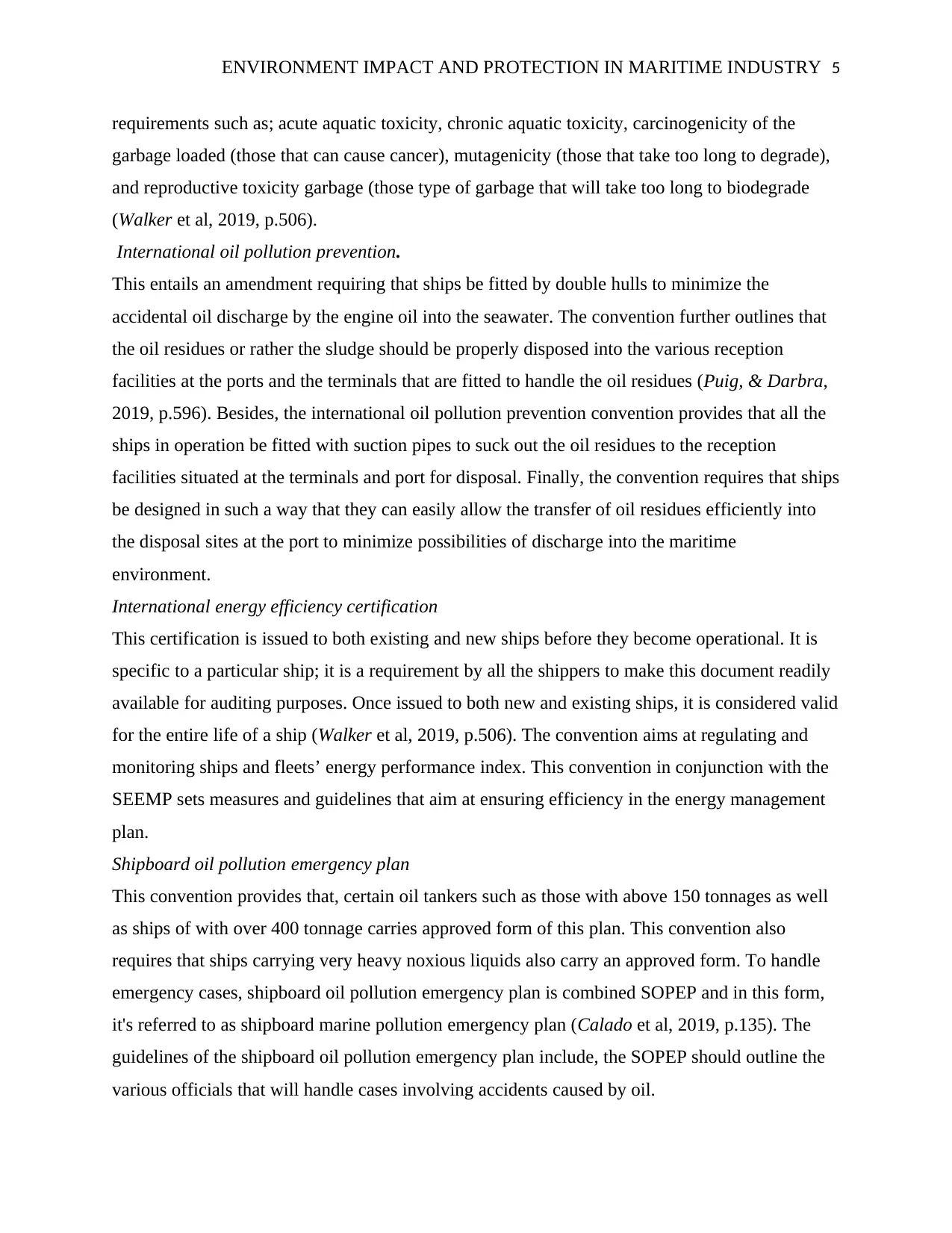
ENVIRONMENT IMPACT AND PROTECTION IN MARITIME INDUSTRY 5
requirements such as; acute aquatic toxicity, chronic aquatic toxicity, carcinogenicity of the
garbage loaded (those that can cause cancer), mutagenicity (those that take too long to degrade),
and reproductive toxicity garbage (those type of garbage that will take too long to biodegrade
(Walker et al, 2019, p.506).
International oil pollution prevention.
This entails an amendment requiring that ships be fitted by double hulls to minimize the
accidental oil discharge by the engine oil into the seawater. The convention further outlines that
the oil residues or rather the sludge should be properly disposed into the various reception
facilities at the ports and the terminals that are fitted to handle the oil residues (Puig, & Darbra,
2019, p.596). Besides, the international oil pollution prevention convention provides that all the
ships in operation be fitted with suction pipes to suck out the oil residues to the reception
facilities situated at the terminals and port for disposal. Finally, the convention requires that ships
be designed in such a way that they can easily allow the transfer of oil residues efficiently into
the disposal sites at the port to minimize possibilities of discharge into the maritime
environment.
International energy efficiency certification
This certification is issued to both existing and new ships before they become operational. It is
specific to a particular ship; it is a requirement by all the shippers to make this document readily
available for auditing purposes. Once issued to both new and existing ships, it is considered valid
for the entire life of a ship (Walker et al, 2019, p.506). The convention aims at regulating and
monitoring ships and fleets’ energy performance index. This convention in conjunction with the
SEEMP sets measures and guidelines that aim at ensuring efficiency in the energy management
plan.
Shipboard oil pollution emergency plan
This convention provides that, certain oil tankers such as those with above 150 tonnages as well
as ships of with over 400 tonnage carries approved form of this plan. This convention also
requires that ships carrying very heavy noxious liquids also carry an approved form. To handle
emergency cases, shipboard oil pollution emergency plan is combined SOPEP and in this form,
it's referred to as shipboard marine pollution emergency plan (Calado et al, 2019, p.135). The
guidelines of the shipboard oil pollution emergency plan include, the SOPEP should outline the
various officials that will handle cases involving accidents caused by oil.
requirements such as; acute aquatic toxicity, chronic aquatic toxicity, carcinogenicity of the
garbage loaded (those that can cause cancer), mutagenicity (those that take too long to degrade),
and reproductive toxicity garbage (those type of garbage that will take too long to biodegrade
(Walker et al, 2019, p.506).
International oil pollution prevention.
This entails an amendment requiring that ships be fitted by double hulls to minimize the
accidental oil discharge by the engine oil into the seawater. The convention further outlines that
the oil residues or rather the sludge should be properly disposed into the various reception
facilities at the ports and the terminals that are fitted to handle the oil residues (Puig, & Darbra,
2019, p.596). Besides, the international oil pollution prevention convention provides that all the
ships in operation be fitted with suction pipes to suck out the oil residues to the reception
facilities situated at the terminals and port for disposal. Finally, the convention requires that ships
be designed in such a way that they can easily allow the transfer of oil residues efficiently into
the disposal sites at the port to minimize possibilities of discharge into the maritime
environment.
International energy efficiency certification
This certification is issued to both existing and new ships before they become operational. It is
specific to a particular ship; it is a requirement by all the shippers to make this document readily
available for auditing purposes. Once issued to both new and existing ships, it is considered valid
for the entire life of a ship (Walker et al, 2019, p.506). The convention aims at regulating and
monitoring ships and fleets’ energy performance index. This convention in conjunction with the
SEEMP sets measures and guidelines that aim at ensuring efficiency in the energy management
plan.
Shipboard oil pollution emergency plan
This convention provides that, certain oil tankers such as those with above 150 tonnages as well
as ships of with over 400 tonnage carries approved form of this plan. This convention also
requires that ships carrying very heavy noxious liquids also carry an approved form. To handle
emergency cases, shipboard oil pollution emergency plan is combined SOPEP and in this form,
it's referred to as shipboard marine pollution emergency plan (Calado et al, 2019, p.135). The
guidelines of the shipboard oil pollution emergency plan include, the SOPEP should outline the
various officials that will handle cases involving accidents caused by oil.
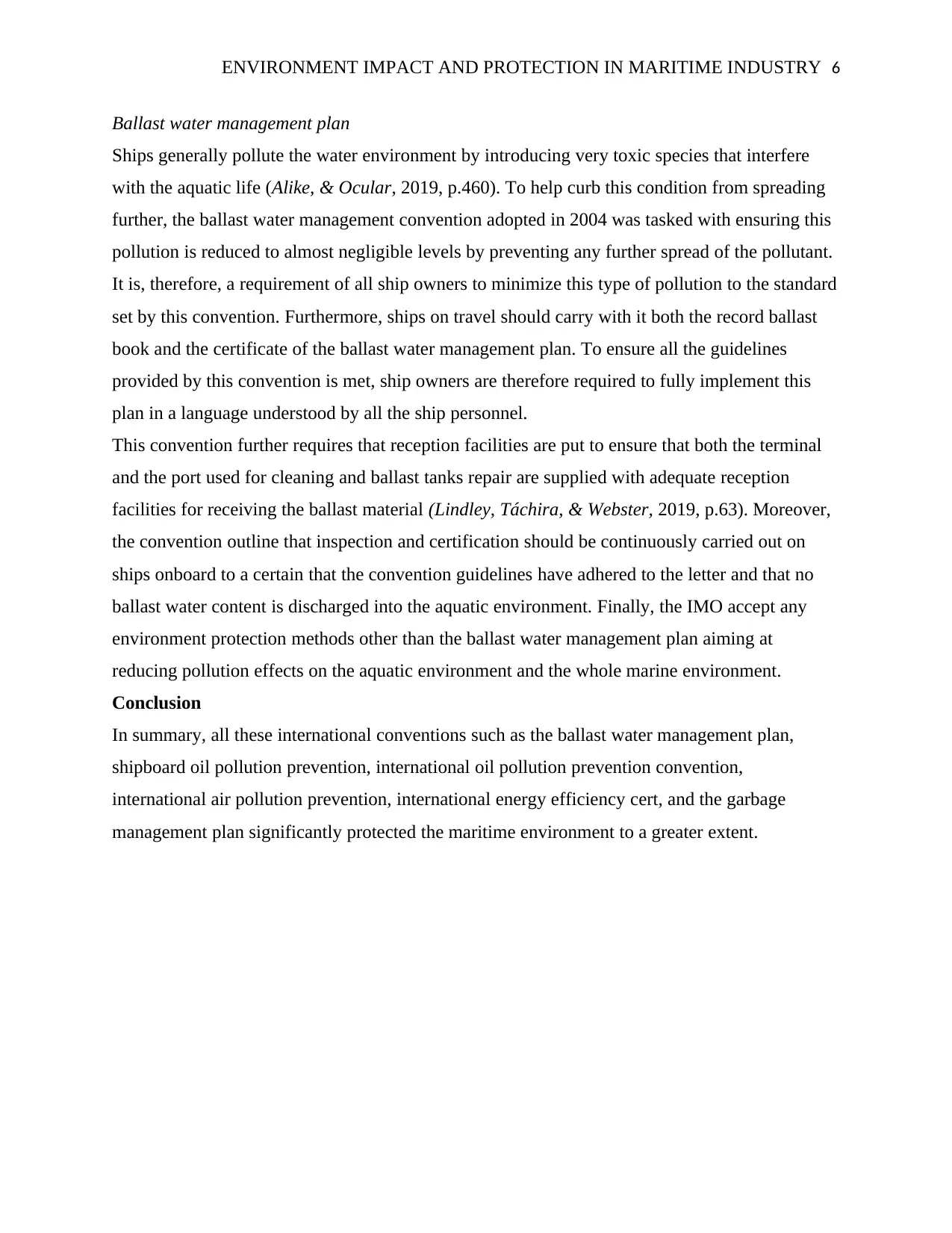
ENVIRONMENT IMPACT AND PROTECTION IN MARITIME INDUSTRY 6
Ballast water management plan
Ships generally pollute the water environment by introducing very toxic species that interfere
with the aquatic life (Alike, & Ocular, 2019, p.460). To help curb this condition from spreading
further, the ballast water management convention adopted in 2004 was tasked with ensuring this
pollution is reduced to almost negligible levels by preventing any further spread of the pollutant.
It is, therefore, a requirement of all ship owners to minimize this type of pollution to the standard
set by this convention. Furthermore, ships on travel should carry with it both the record ballast
book and the certificate of the ballast water management plan. To ensure all the guidelines
provided by this convention is met, ship owners are therefore required to fully implement this
plan in a language understood by all the ship personnel.
This convention further requires that reception facilities are put to ensure that both the terminal
and the port used for cleaning and ballast tanks repair are supplied with adequate reception
facilities for receiving the ballast material (Lindley, Táchira, & Webster, 2019, p.63). Moreover,
the convention outline that inspection and certification should be continuously carried out on
ships onboard to a certain that the convention guidelines have adhered to the letter and that no
ballast water content is discharged into the aquatic environment. Finally, the IMO accept any
environment protection methods other than the ballast water management plan aiming at
reducing pollution effects on the aquatic environment and the whole marine environment.
Conclusion
In summary, all these international conventions such as the ballast water management plan,
shipboard oil pollution prevention, international oil pollution prevention convention,
international air pollution prevention, international energy efficiency cert, and the garbage
management plan significantly protected the maritime environment to a greater extent.
Ballast water management plan
Ships generally pollute the water environment by introducing very toxic species that interfere
with the aquatic life (Alike, & Ocular, 2019, p.460). To help curb this condition from spreading
further, the ballast water management convention adopted in 2004 was tasked with ensuring this
pollution is reduced to almost negligible levels by preventing any further spread of the pollutant.
It is, therefore, a requirement of all ship owners to minimize this type of pollution to the standard
set by this convention. Furthermore, ships on travel should carry with it both the record ballast
book and the certificate of the ballast water management plan. To ensure all the guidelines
provided by this convention is met, ship owners are therefore required to fully implement this
plan in a language understood by all the ship personnel.
This convention further requires that reception facilities are put to ensure that both the terminal
and the port used for cleaning and ballast tanks repair are supplied with adequate reception
facilities for receiving the ballast material (Lindley, Táchira, & Webster, 2019, p.63). Moreover,
the convention outline that inspection and certification should be continuously carried out on
ships onboard to a certain that the convention guidelines have adhered to the letter and that no
ballast water content is discharged into the aquatic environment. Finally, the IMO accept any
environment protection methods other than the ballast water management plan aiming at
reducing pollution effects on the aquatic environment and the whole marine environment.
Conclusion
In summary, all these international conventions such as the ballast water management plan,
shipboard oil pollution prevention, international oil pollution prevention convention,
international air pollution prevention, international energy efficiency cert, and the garbage
management plan significantly protected the maritime environment to a greater extent.
⊘ This is a preview!⊘
Do you want full access?
Subscribe today to unlock all pages.

Trusted by 1+ million students worldwide
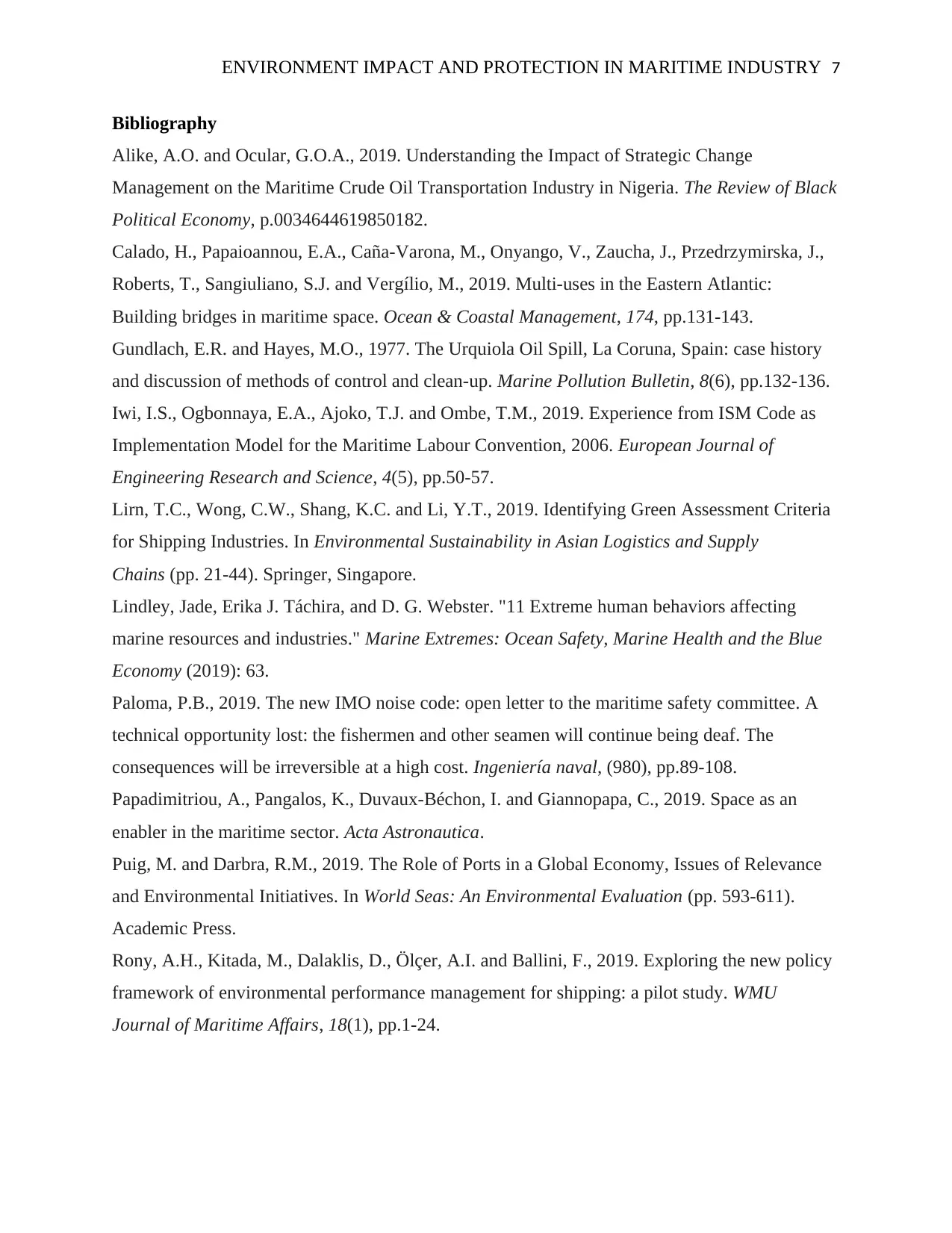
ENVIRONMENT IMPACT AND PROTECTION IN MARITIME INDUSTRY 7
Bibliography
Alike, A.O. and Ocular, G.O.A., 2019. Understanding the Impact of Strategic Change
Management on the Maritime Crude Oil Transportation Industry in Nigeria. The Review of Black
Political Economy, p.0034644619850182.
Calado, H., Papaioannou, E.A., Caña-Varona, M., Onyango, V., Zaucha, J., Przedrzymirska, J.,
Roberts, T., Sangiuliano, S.J. and Vergílio, M., 2019. Multi-uses in the Eastern Atlantic:
Building bridges in maritime space. Ocean & Coastal Management, 174, pp.131-143.
Gundlach, E.R. and Hayes, M.O., 1977. The Urquiola Oil Spill, La Coruna, Spain: case history
and discussion of methods of control and clean-up. Marine Pollution Bulletin, 8(6), pp.132-136.
Iwi, I.S., Ogbonnaya, E.A., Ajoko, T.J. and Ombe, T.M., 2019. Experience from ISM Code as
Implementation Model for the Maritime Labour Convention, 2006. European Journal of
Engineering Research and Science, 4(5), pp.50-57.
Lirn, T.C., Wong, C.W., Shang, K.C. and Li, Y.T., 2019. Identifying Green Assessment Criteria
for Shipping Industries. In Environmental Sustainability in Asian Logistics and Supply
Chains (pp. 21-44). Springer, Singapore.
Lindley, Jade, Erika J. Táchira, and D. G. Webster. "11 Extreme human behaviors affecting
marine resources and industries." Marine Extremes: Ocean Safety, Marine Health and the Blue
Economy (2019): 63.
Paloma, P.B., 2019. The new IMO noise code: open letter to the maritime safety committee. A
technical opportunity lost: the fishermen and other seamen will continue being deaf. The
consequences will be irreversible at a high cost. Ingeniería naval, (980), pp.89-108.
Papadimitriou, A., Pangalos, K., Duvaux-Béchon, I. and Giannopapa, C., 2019. Space as an
enabler in the maritime sector. Acta Astronautica.
Puig, M. and Darbra, R.M., 2019. The Role of Ports in a Global Economy, Issues of Relevance
and Environmental Initiatives. In World Seas: An Environmental Evaluation (pp. 593-611).
Academic Press.
Rony, A.H., Kitada, M., Dalaklis, D., Ölçer, A.I. and Ballini, F., 2019. Exploring the new policy
framework of environmental performance management for shipping: a pilot study. WMU
Journal of Maritime Affairs, 18(1), pp.1-24.
Bibliography
Alike, A.O. and Ocular, G.O.A., 2019. Understanding the Impact of Strategic Change
Management on the Maritime Crude Oil Transportation Industry in Nigeria. The Review of Black
Political Economy, p.0034644619850182.
Calado, H., Papaioannou, E.A., Caña-Varona, M., Onyango, V., Zaucha, J., Przedrzymirska, J.,
Roberts, T., Sangiuliano, S.J. and Vergílio, M., 2019. Multi-uses in the Eastern Atlantic:
Building bridges in maritime space. Ocean & Coastal Management, 174, pp.131-143.
Gundlach, E.R. and Hayes, M.O., 1977. The Urquiola Oil Spill, La Coruna, Spain: case history
and discussion of methods of control and clean-up. Marine Pollution Bulletin, 8(6), pp.132-136.
Iwi, I.S., Ogbonnaya, E.A., Ajoko, T.J. and Ombe, T.M., 2019. Experience from ISM Code as
Implementation Model for the Maritime Labour Convention, 2006. European Journal of
Engineering Research and Science, 4(5), pp.50-57.
Lirn, T.C., Wong, C.W., Shang, K.C. and Li, Y.T., 2019. Identifying Green Assessment Criteria
for Shipping Industries. In Environmental Sustainability in Asian Logistics and Supply
Chains (pp. 21-44). Springer, Singapore.
Lindley, Jade, Erika J. Táchira, and D. G. Webster. "11 Extreme human behaviors affecting
marine resources and industries." Marine Extremes: Ocean Safety, Marine Health and the Blue
Economy (2019): 63.
Paloma, P.B., 2019. The new IMO noise code: open letter to the maritime safety committee. A
technical opportunity lost: the fishermen and other seamen will continue being deaf. The
consequences will be irreversible at a high cost. Ingeniería naval, (980), pp.89-108.
Papadimitriou, A., Pangalos, K., Duvaux-Béchon, I. and Giannopapa, C., 2019. Space as an
enabler in the maritime sector. Acta Astronautica.
Puig, M. and Darbra, R.M., 2019. The Role of Ports in a Global Economy, Issues of Relevance
and Environmental Initiatives. In World Seas: An Environmental Evaluation (pp. 593-611).
Academic Press.
Rony, A.H., Kitada, M., Dalaklis, D., Ölçer, A.I. and Ballini, F., 2019. Exploring the new policy
framework of environmental performance management for shipping: a pilot study. WMU
Journal of Maritime Affairs, 18(1), pp.1-24.
Paraphrase This Document
Need a fresh take? Get an instant paraphrase of this document with our AI Paraphraser
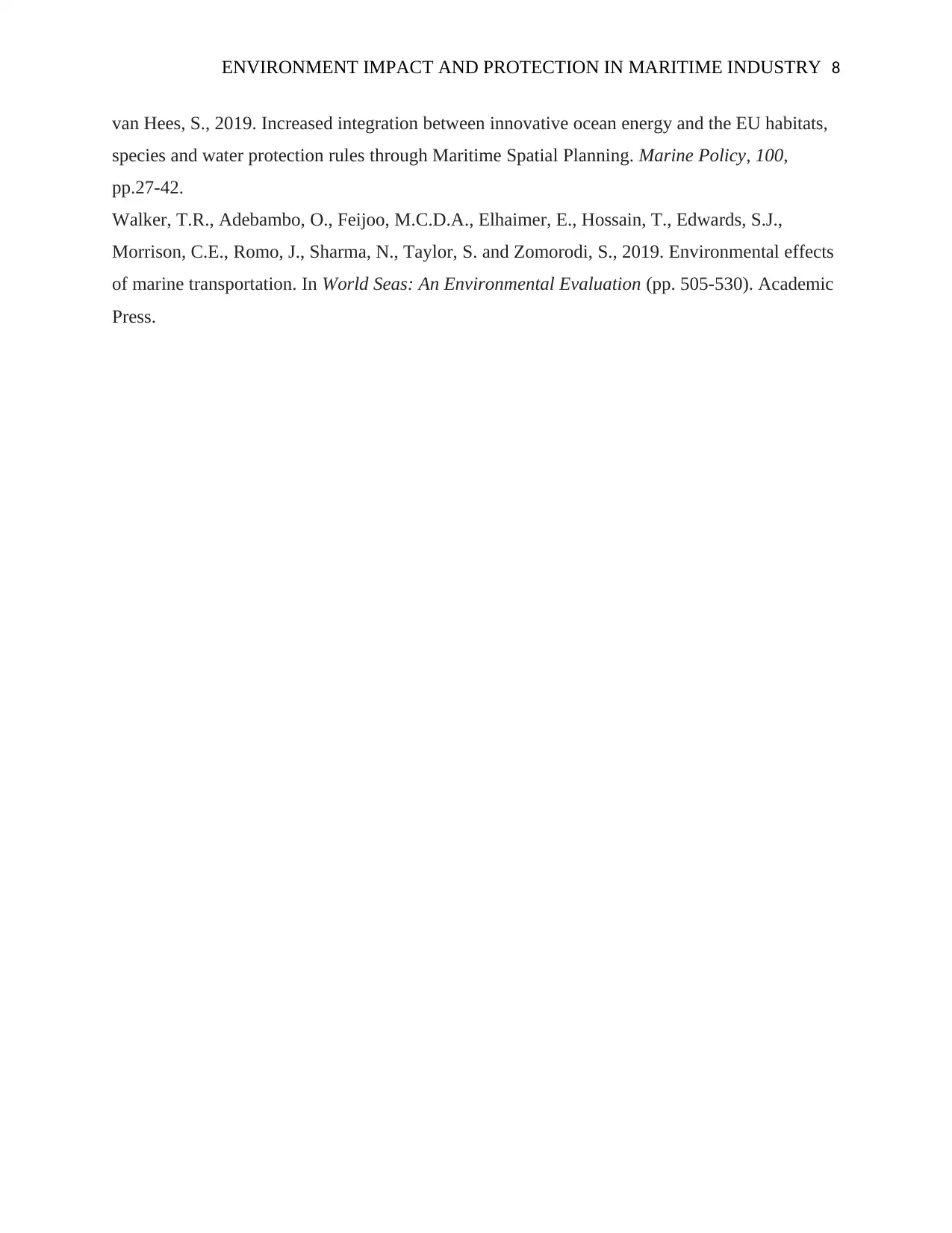
ENVIRONMENT IMPACT AND PROTECTION IN MARITIME INDUSTRY 8
van Hees, S., 2019. Increased integration between innovative ocean energy and the EU habitats,
species and water protection rules through Maritime Spatial Planning. Marine Policy, 100,
pp.27-42.
Walker, T.R., Adebambo, O., Feijoo, M.C.D.A., Elhaimer, E., Hossain, T., Edwards, S.J.,
Morrison, C.E., Romo, J., Sharma, N., Taylor, S. and Zomorodi, S., 2019. Environmental effects
of marine transportation. In World Seas: An Environmental Evaluation (pp. 505-530). Academic
Press.
van Hees, S., 2019. Increased integration between innovative ocean energy and the EU habitats,
species and water protection rules through Maritime Spatial Planning. Marine Policy, 100,
pp.27-42.
Walker, T.R., Adebambo, O., Feijoo, M.C.D.A., Elhaimer, E., Hossain, T., Edwards, S.J.,
Morrison, C.E., Romo, J., Sharma, N., Taylor, S. and Zomorodi, S., 2019. Environmental effects
of marine transportation. In World Seas: An Environmental Evaluation (pp. 505-530). Academic
Press.
1 out of 8
Related Documents
Your All-in-One AI-Powered Toolkit for Academic Success.
+13062052269
info@desklib.com
Available 24*7 on WhatsApp / Email
![[object Object]](/_next/static/media/star-bottom.7253800d.svg)
Unlock your academic potential
Copyright © 2020–2025 A2Z Services. All Rights Reserved. Developed and managed by ZUCOL.





